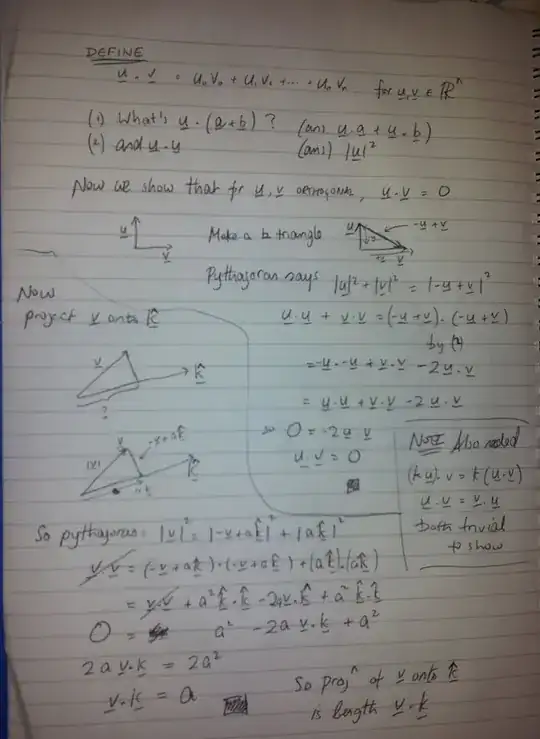I'm aware that we can project an arbitrary vector $v$ onto a unit vector $\hat{\mathbf{k}}$ by $(\mathbf{v} \cdot \hat{\mathbf{k}})\hat{\mathbf{k}}$
But why is this true?
I would imagine that such a clean result has a correspondingly clean derivation. But I can't see it.
The Wikipedia page on vector projection http://en.wikipedia.org/wiki/Vector_projection makes use of the dot product rule in order to prove it. A cancellation occurs which removes $cos(\theta)$.
To illustrate, if we work in 2D, we take a vector $\mathbf{k}$ on the unit circle, and then rotate it 90° counterclockwise to get $\mathbf{k}'$.
Now given an arbitrary unit vector $\mathbf{v}$, we can write $\mathbf{v}$ in terms of $\mathbf{k}$ and $\mathbf{k'}$: $\mathbf{v} = \cos(\theta) \mathbf{k} + \sin(\theta) \mathbf{k}'$ where $\theta$ is the angle between $\mathbf{v}$ and $\mathbf{k}$.
So the projection in the $\mathbf{k}$ direction is $\cos(\theta)$
And if we are allowed the dot product rule, then for unit $\mathbf{k}$ and $\mathbf{v}$, we have $\mathbf{k} \cdot \mathbf{v} = \cos(\theta)$
So the projection in the $\mathbf{k}$ direction is $k \cdot v$
But then this motivates the question: Why is the dot product rule true?
The Wikipedia page on the dot product rule surprisingly defines $\cos(\theta)$ as $\mathbf{k \cdot v}$
This doesn't make any sense to me. $\cos(\theta)$ is defined far more clearly as projection of circular motion, i.e. defined geometrically.
It must be possible to set up some geometrical construction, whereby the dot-product falls out as a consequence.
But how to go about this?
EDIT: Link: How to understand dot product is the angle's cosine?

\cdotas opposed to\bullet. The latter looks far too fat. – kahen Apr 06 '14 at 19:53